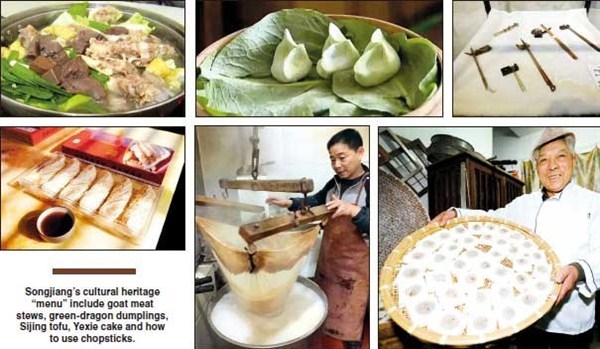今日上海
松江特色小吃—舌尖上的“非遗” - 2017年07月14日
Culturally, we are what we eat

SONGJIANG honored its specialty foods with the recent announcement of the latest additions to the list of district “intangible cultural heritage.”
The list covers a “menu” of hearty dishes, plus the local culture of chopstick use.
The “main course” is the goat meat of Zhangze Village. During the Yuan Dynasty (1271-1368), Sha Shuan, the Songjiang governor, was a Mongolian who loved goat meat so much that he ordered the animals we farmed in the area.
Local residents soon joined him in his love of the meat and came up with creative ways of preparing it. The most famous local dishes nowadays are steamed sliced goat meat, red braised goat meat and minced goat meat. For true aficionados, also a hot pot includes goat blood and offal. Local farmers still practice the traditional method of a steamboat in a wooden vat on a clay oven.
Zhangze Village holds an annual goat meat festival every winter, a season favorable to a meat that is said to heat the body.
A second main dish on the heritage “menu” is qinglong, or “green dragon” dumplings. They were considered a sacrifice offering to ancestors during ancient observances of the springtime Tomb Sweeping Festival.
The dumplings are arranged in a big bowl to resemble the shape of a dragon. The name qinglong comes from a namesake grass that gives the dumplings a natural green color.
To make the dumplings, the grass is pounded into a mulch and the green juice is extracted and added to the dough for the dumpling skins. Fillings are made from lard oil, sugar, jujubes and red soybean paste.
Another “menu” dish is Sijing tofu. It is made by a technique pioneered in the humble tofu shop of the Wang family in the late Qing Dynasty (1644-1912).
The technique is used to produce dried tofu, soybean milk, bean-curd stick, fried bean curd and fermented “stinky” bean curd, all made with hand skills passed down for 100 years.
The crucial step to making good tofu is dian jiang, a process of solidifying boiled soybean milk. The Wang family has kept the brine a family secret, though a special seaweed is believed to give the curd its distinctive taste.
And finally, the heritage “menu” includes a dessert called Dragon’s Whiskers, a sort of candy floss wrapped around ground peanuts or sesame seeds.
The process involves a dough-like mixture of sugar, syrup and rice flour whisked into small, thin strands that melt in the mouth.
The recipe dates back to the Three Kingdoms Period (222-280 AD), when Cao Cao, the lord of the Wei, loved the candy and gave it its name.
After nearly 2,000 years, the original preparation method remains the same. Songjiang confectioner Liu Tangzhi learned the skill from a master about 20 years ago in Beijing and has carried on the tradition.
Liu first opened a candy factory in Beijing and Tianjin, and the snack soon became popular in northern China. He late brought the technique to Songjiang.
Liu said the key is to make the “whiskers” as thin as possible. “Generally speaking, there should be at least 10,000 whiskers,” he said.
Also included on the new heritage list is Songjiang chopstick etiquette. Since the Ming Dynasty (1368-1644), local residents have developed a whole ritual of chopstick use, such as how to properly use them when dining and how to maintain chopsticks made of jade, bamboo or gems.
